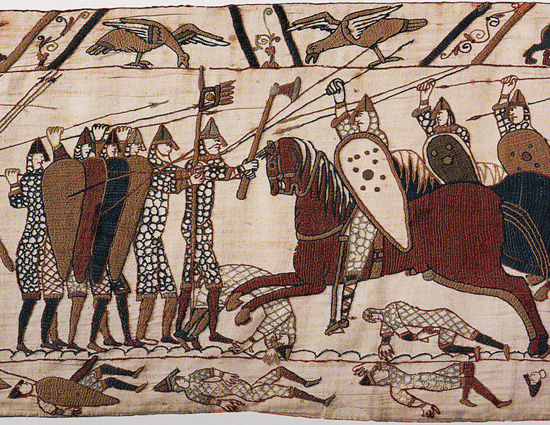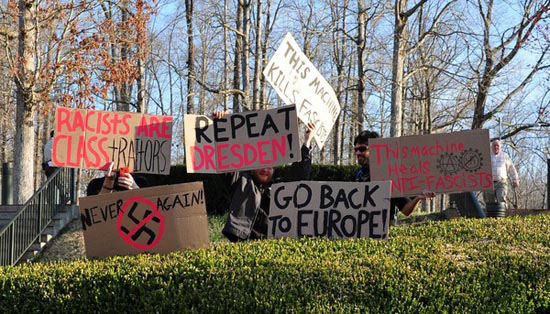Why Are Europeans More Racially Aware?
Matthew Contessini, American Renaissance, July 31, 2013
One of the most perplexing differences between whites who are native English speakers — whom the French call Anglo-Saxons — and continental Europeans is their attitude toward white nationalism and the rights of whites.
In the United States, which is home to more whites than any other country, freedom of speech and association are constitutionally protected rights, but meetings of American Renaissance and other pro-white organizations are disrupted by people who hate us. Even traditional supporters of the First Amendment, such as the ACLU, libertarians, the Heritage Foundation, and Cato Institute take absolutely no interest in the trampling of our rights.
In Britain as well, pro-white organizations are attacked by radicals, vilified by the media, and shunned by the mainstream. Canada and Australia are no different.
In continental Europe, on the other hand, pro-white organizations are thriving. In France, the National Front is an influential and popular party, while the Bloc Identitaire is a rising youth movement. In Holland, Austria, and Switzerland, the Party for Freedom, the Freedom Party, and the Swiss People’s Party, respectively, are very strong. In Greece and Hungary, ultranationalist pro-white parties are surging. Since these movements are supported by millions of people, attempts by fringe groups to silence them would not be tolerated.
Why are continental Europeans more racially aware and much more resistant to the destruction of their heritage than whites from countries that were founded by the British?
There are many differences between the two groups of nations that influence their views and behavior about race. The most obvious difference is geographic. Because Britain, North America, Australia and New Zealand are geographically isolated, they have not been the victims of conquest by alien invaders, whereas the history of continental Europe is the story of endless conquests, often by savage Asiatic and Middle-Eastern tribes such as the Huns, Mongols, Tatars, Arabs and Turks.
Conquest and oppression in Europe lasted throughout the 20th century. European ethnicities suffered endless turmoil that is forever etched in their collective memories, whereas the last successful invasion of an Anglo-Saxon nation was in 1066.

In this scene from the Bayeux Tapestry, mounted Normans attack Anglo-Saxon infantry at the Battle of Hastings.
These different experiences resulted in different attitudes toward alien intruders. While Europeans are instinctively suspicious of foreigners that have brought them so much horror over the centuries, Anglo-Saxons, who did not experience the same fate — but were often conquerors themselves — have not developed that same defensive traits.
Continental Europeans have a profound knowledge of their neighbors, who are often traditional adversaries. Americans, who do not have a similar historical experience, have relatively little knowledge or interest in either Canadians or Mexican re-conquistadors.
Thus, when Americans see millions of Mexicans streaming across the border, the alarm does not go off, as it would for continental Europeans. White Americans see intruders as people who are “like us,” just looking for a better life. The invading Mexicans, on the other hand, see their misguided hosts as people who “stole” the Southwest from their fledgling nation in the 1840s. While Mexicans dream of recapturing the mythical Aztlan, their white hosts see no further than the fact that Mexicans do inexpensive yard work. For most whites that is all that matters.
The European nations that are the most ethnically aware are those that were most savagely conquered most recently, such as the Balkan nations that were victims of the Ottoman Empire, Mediterranean nations that were targeted by Arabs, and, of course, the Eastern Europeans, who were in the path of Asiatic hordes, the German war machine, and the brutal Soviet Union.
There are other differences between Anglo-Saxons and continental Europeans. For example, land is plentiful in sparsely populated North America and Australia. White settlers took over vast tracts of land that they put to good economic use, but to which they had limited emotional attachment. Consequently, Americans respond to the influx of nonwhites into their neighborhoods and communities by moving to the suburbs, exurbs, countryside, or out of state. The territory they are giving up to alien races is not important to whites as long as they are able to find some other place where they can live in peace.
Europeans have a completely different attitude toward their ancestral lands, where families and communities may have lived for centuries. In densely populated parts of Europe, ownership of as little as a few acres of farmland meant the difference between surviving as a family and dying from starvation. Centuries of often bloody battles between indentured peasants and their feudal landlords forged emotional ties between white Europeans and their land. That’s why they have much lower tolerance for alien people who take treasured real estate that generations of their ancestors may have died to protect. Also, because many Americans move often during their lifetimes and live in several different states, this weakens the ties to their family roots.
Americans often do not know the names of their ancestors beyond their grandparents. Families often represent a mix of several European ethnicities, which complicates efforts to maintain family traditions. American family histories are often fuzzy, sugarcoated stories, often involving Ellis Island, and occasionally an elusive Indian princess. Not surprisingly, white Americans often have little interest in maintaining family traditions once their ancestral Irish, Polish, or Italian family ties weaken through assimilation.
In Europe, ethnic and family roots run deep. In rural areas, families have often lived in the same communities for hundreds of years. Strong ethnic ties, forged over centuries of joint struggle for survival, have created a sense among continental Europeans that their ethnicity represents their extended family. That defensive mechanism, the strongest bulwark against alien encroachment, seems to have disappeared among white Americans, which makes the United States more vulnerable to alien invasion.
In Europe, property stays in the family, often for many generations. In Mediterranean nations it is not uncommon for families to live in the same stone houses for centuries. This tradition reinforces the sense of kinship and allegiance to the family, region, ethnicity, nation and race. Americans, on the other hand, seem much more interested in their share of the money from liquidating grandpa’s estate rather than keeping his pocket watch.
Recently, Jason Richwine was fired from his position at the Heritage Foundation because of his studies of group IQ differences and what they mean for immigration policy. The American public and their elected representatives are apparently not allowed to have an interest in the quality of their immigrant population, even though ignoring quality has catastrophic consequences.
Unlike Americans, continental Europeans have a keen interest in differences between races and ethnicities. Every European ethnicity has a well-deserved, widely-known reputation. Consequently, when German author Thilo Sarrazin published a book in 2011 which concluded that Turks and other nonwhite immigrants are “dumbing down” German society due to their low average IQ, he started a national dialog on the quality of immigrant population. While he was eventually forced to resign from his position at the Bundesbank, Mr. Sarazzin remains a popular, respected, and influential public figure in Germany.
Several years ago, when Turkey was negotiating entry into the European Union, its bid was strongly supported by the governments of Britain and the United States. Germans, however, are painfully aware of the consequences of the Turkish presence in Germany and since Ottoman Turks have a horrible reputation among the Europeans that had a misfortune of interacting with them over the centuries, Turkey’s entry was effectively blocked.
American elites and many whites view the United States as a boarding house that is open to masses of Third-World immigrants. They apparently believe that this gigantic social experiment will somehow be successful despite all the evidence to the contrary.
For continental Europeans, the concept of a nation is inextricably tied to ethnicity. Even within a multiethnic nation such as Belgium, the ethnic lines are sharp. The idea that welcoming millions of nonwhite immigrants would somehow “strengthen” ethnically homogenous European nations, such as Poland, Slovakia or Finland, by fostering “diversity” would be considered completely preposterous.
In European nations that are exposed to massive third world immigration, such as Holland, Italy, Greece, and France there is a strong backlash against intruders among the native populations. Immigrants are not accepted and are instead confined to separate ethnic enclaves.
The United States gives citizenship to any child born on US soil, regardless of the citizenship or legal status of child’s parents. Pregnant Mexican women customarily sneak across the border to give birth, and there are organizations that bring pregnant Chinese women to the United States for the sole purpose of getting citizenship for their newborns.
In European countries, citizenship is not a birthright, but is tied to ethnicity. Italian-Americans and Irish-Americans can obtain citizenship from the countries that their ancestors came from, while children born to legal immigrants residing in these countries usually cannot.
White Americans seem to have no interest in protecting their own culture. In the current immigration debate, not a single politician highlighted the need to protect traditional American culture and heritage. The level of disdain that white Americans have toward their own heritage is demonstrated by the fact that US citizens can get ballots in many different languages. Los Angeles County, for example, was required to print ballots for the 2012 elections in Spanish, Chinese, Filipino, Japanese, Korean, Vietnamese, Khmer, Thai and Hindi. How can someone who can’t even speak English be considered an American citizen?
In continental Europe, candidates for naturalization that have no ethnic ties to the nation have to pass extensive tests of their level of cultural assimilation. In Switzerland, this includes unannounced home visits by pedantic government officials who check, among other things, the level of cleanliness of the applicant’s bathroom. The Swiss do not believe in granting citizenship to applicants who cling to Third-World notions of hygiene. We can only imagine what would happen if someone suggested similar screening in the United States.
American policy-makers insist that Islam is no obstacle to assimilation, despite countless examples of Muslim hatred of America and Muslim violence against Americans. In continental European countries with large Muslim populations such as Holland and France, the Party for Freedom and National Front are fully aware of the irreconcilable differences between Christianity and Islam. They have made elimination of Muslim immigration a centerpiece of their respective platforms.
They do so despite laws that make it a crime to belittle Islam. Dutch politician Geert Wilders was put on trial for speech-crimes against Islam, but was acquitted in June 2011. Marine Le Pen was stripped of immunity in the European Parliament in July 2013 to open the way for her trial on charges of racism over comments she made comparing Muslim street prayers to an occupation of French territory.
While courageous European dissident politicians are willing to risk their freedom by telling the truth, American politicians are neither dissidents, nor interested in telling the truth, let alone in saving White America — even though all of those things are perfectly legal in the United States!
To understand fully the differences between Anglo-Saxons and continental Europeans we must also analyze the differences in mentality, views, and behavior of ordinary people. The individualistic traits common among Anglo-Saxons generally foster multiculturalism and integration, while a greater community orientation among continental Europeans supports ethnocentrism and segregation. The differences in constitutions, electoral and court systems, and the level and protection of personal liberties also have racial ramifications.
These differences are also a promising area of study.
















